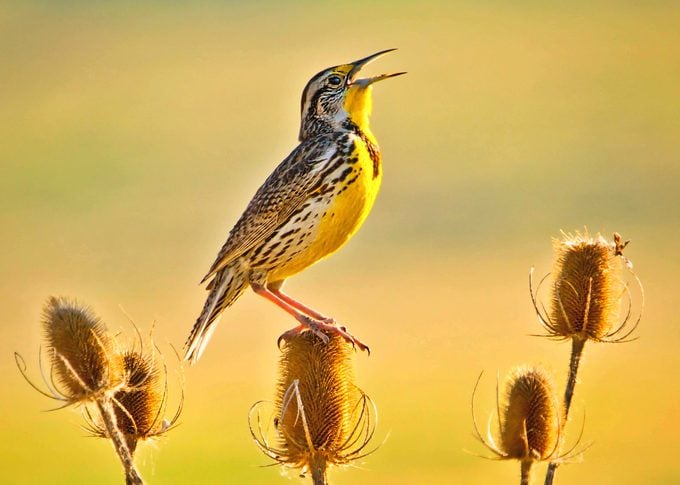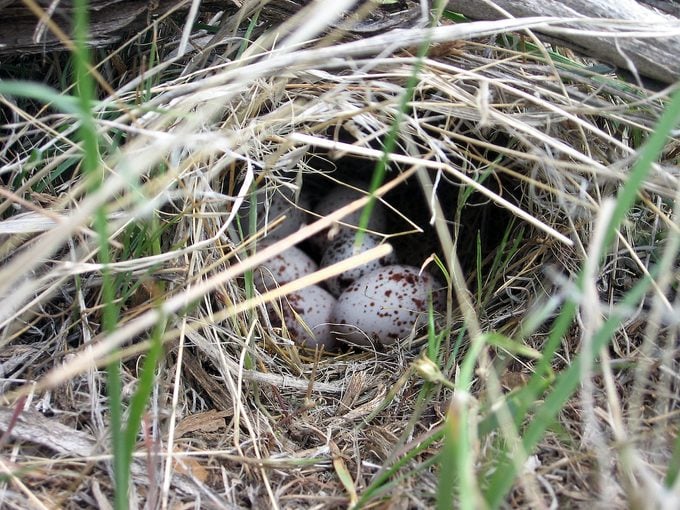Western Meadowlark: Songbird of the Vast Grasslands
Updated: Jun. 20, 2024
Learn what a western meadowlark looks like and sounds like and where birders can find this large, colorful songbird.
On This Page
What Does a Western Meadowlark Look Like?

Juli Bosmoe, senior range ecologist for Audubon Great Falls in Fargo, North Dakota, points out that the easiest feature to spot on the western meadowlark is the yellow breast with a v-shaped black bib. She also says to look for the white outer tail feathers that flash when the bird flushes from a perch. These features are shared by two other species that are almost identical, the eastern meadowlark and Chihuahuan meadowlark.
Around the size of a robin, Juli says, “They’re big for a songbird, for sure.” They also have long, slender bills.
Adult males and females look similar. Immature birds are paler in color.
Did you know: Despite having lark in their name, these birds are related to blackbirds.
Range/Habitat

“They prefer grasslands without trees that are encroaching because these provide a perch for predator birds,” says Juli.
Throughout the year, they inhabit the a large portion of the western U.S., from southern Nebraska to the West Coast, and south into Mexico. In summer, their reach extends into Canada, Montana, the Dakotas, Minnesota and Wisconsin.
These birds are early spring and late fall migrants.
Check out more yellow and black birds you should know.
What Do Western Meadowlarks Eat?

“During the breeding season they like insects the most. It’s a lot of good energy in a small package,” explains Juli. “Outside of the breeding season they’re more likely to be eating seeds, which is why it’s important to have these diverse grasslands.”
Even though they do consume seeds as part of their diet, she notes, “They’re not going to be your backyard feeder bird.” Juli says of one of their favorite ways to find their seeds is by sticking their beaks in a cow pie to get out the seeds.
The ideal habit for western meadowlarks is an expansive grassland with diverse grassland species, but there are many instances where development or agricultural practices reduce these food options for the birds.
“If the grassland is stagnant, it’s just going to turn into a lot of older grasses,” she says. “It is typically invaded by smooth brome and Kentucky bluegrass.” One of the best ways we can support these grassland birds is to keep our own backyards as diverse as possible with native grasses.
Nesting Habits

“The male mates with more than one female, but it may be only two,” notes Juli.
They are very territorial during the breeding season, using their songs to woo a female, as well as ward off intruders.
“They have great, hidden nests,” she explains. The female gathers all of the materials and builds the nest, which is positioned on the ground, often near a bunch of grasses or placed within a depression. Built of grasses and dried forbs, the six to seven-inch diameter nest blends perfectly with the surrounding vegetation.
“The female will tuck grasses over the top,” she says, and camouflage roof makes them nearly impossible to see, even when you’re looking for them.
“(Western) meadowlarks usually have two breeds year, and the female takes care of the young,” says Juli.
The five to six white eggs per clutch are heavily spotted with lavender, brown or rust markings, which adds to their concealment qualities. It requires 13 to 16 days for them to hatch, and the young leave the nest after 10 to 18 days.
Western Meadowlark Song

Their distinctive, remarkably loud song makes western meadowlarks unmistakable. “To me, that’s one of the key features, of how loud they are. You could be driving down the gravel road with the windows up, and you can still hear them,” Juli says.
“(Males) really like a post to sit on, such as fences or barbed wired, to sing for the ladies,” says Juli. “They have a whole repertoire of songs because the males are trying to attract the females. They can have 100 different variations. The females judge them on their songs.”
Sometimes described as “flute-like,” their songs vary with whistles, gurgles and warbling sounds. But once you hear it, you recognize it immediately.
Bird sounds courtesy of the Cornell Lab of Ornithology
Western Meadowlark vs Eastern Meadowlark

Two other meadowlark species live in North America. The eastern meadowlark is found from the edge of the Great Plains east to the Atlantic Coast, and from the Great Lakes region south to Texas. It overlaps with the western meadowlark from Minnesota south to Oklahoma. In southern Arizona and New Mexico lives another species, the Chihuahuan meadowlark, which was considered the same species as the eastern meadowlark until 2022.
All three of these birds look almost identical. The western meadowlark shows more yellow at the sides of the throat, the eastern meadowlark is slightly darker brown on the back, and the Chihuahuan meadowlark has more white in the outer tail feathers, but all of these differences are hard to see.
The easiest way to recognize the western meadowlark is by voice. Its rich, fast, bubbling song is very different from the thin, longer whistles of the other two species. Its most common callnote is different, too, a mellow tchook instead of a buzzy dzzert! Apparently the meadowlarks don’t have any trouble telling each other apart, because despite their similarity, they almost never hybridize.
About the Experts
Juli Bosmoe has been with Audubon Great Plains since 2019, and focuses heavily on the working range lands of the eastern parts of North and South Dakota. She earned a bachelor of science degree in wildlife and fisheries management at South Dakota State University.





















